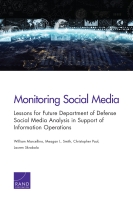PDF file1.2 MB
Research Questions
How could social media analysis contribute to DoD information operations, and which approaches are most applicable?
How can DoD field a robust social media analysis capability while navigating U.S. law and cultural norms?
What are the benefits and drawbacks of DoD's options for integrating social media analysis and tools, such as the use of open-source technologies versus commercial solutions?
Social media analysis is playing an important and increasing role in advertising and academic research, but it also has significant potential to support military information operations by providing a window into the perspectives, thoughts, and communications of a wide range of relevant audiences. Although there are compelling national security reasons to field a social media analysis capability, the U.S. Department of Defense (DoD) must do so while navigating U.S. law and cultural norms and under conditions of great uncertainty. Existing legal and policy frameworks have not anticipated the rapid pace and global reach of modern communication networks, and questions of cost and implementation hinder the development of a robust social media analysis capability and the most fruitful applications for these analyses. To support DoD's assessment of the benefits, trade-offs, and implementation challenges that it will face as it expands its capacity for social media analysis, this report reviews the analytic approaches that will be most valuable for information operations, as well as legal, ethical, policy, technological, and training considerations. It also includes a set of recommendations to help DoD navigate this terrain while building a robust, effective social media analysis capability to support operations worldwide.
Key Findings
Social Media Analysis Could Play a Valuable Role in DoD Information Operations
Social media analysis can provide important information about adversaries, supporting communities on either side of a conflict, or other key populations. It can also inform efforts to target messages to particular audiences or influence the perceptions, decisions, or behaviors of a group.
Social media platforms allow users to share text, images, and videos quickly as events occur. Monitoring this traffic will help ensure that U.S. forces are prepared to respond to developing events or the spread of deceptive information.
U.S. service members' social media use can compromise operational security. Social media analysis could support DoD's prevention efforts.
Crowdsourcing and social media monitoring have played a critical role in humanitarian relief efforts and other civil-military operations by providing the real-time updates needed for a timely and effective response.
Current Legal Structures and Policies Were Not Designed for Information Operations
U.S. law and policy have not kept up with changing adversaries and changes in the types of activities in which U.S. forces engage. Uncertainty about which types of activities are permitted under law is a disincentive for commanders to engage in information operations.
Laws intended to protect privacy and restrict domestic surveillance do not account for key characteristics of social media, such as the intermingling of domestic and foreign communication and the risk that collecting data on another country's populace could involve accidental data collection on U.S. persons.
Recommendations
DoD should conduct a legal review and establish clear policies on the use of social media analysis to support information operations. It should also formulate clear guidelines on data collection, storage, and dissemination.
DoD should directly connect efforts to expand its social media analysis capability with existing information-related capabilities and current threats and operational needs.
DoD should weigh the costs and benefits of using open-source versus commercial technologies and training military personnel to conduct social media analysis versus relying on contractors to perform these tasks.
Table of Contents
Chapter One
The Need for Social Media Monitoring to Support U.S. Department of Defense Information Operations
Chapter Two
How Social Media Analysis Could Support Information Operations
Chapter Three
Social Media Analytical Methods for Supporting Information Operations
Chapter Four
Context and Considerations for the Use of Social Media Analysis in Information Operations
Chapter Five
Recommendations
Research conducted by
This research was sponsored by the Combating Terrorism Technical Support Office and conducted within the International Security and Defense Policy Center of the RAND National Defense Research Institute, a federally funded research and development center sponsored by the Office of the Secretary of Defense, the Joint Staff, the Unified Combatant Commands, the Navy, the Marine Corps, the defense agencies, and the defense Intelligence Community.
This report is part of the RAND Corporation research report series. RAND reports present research findings and objective analysis that address the challenges facing the public and private sectors. All RAND reports undergo rigorous peer review to ensure high standards for research quality and objectivity.
Permission is given to duplicate this electronic document for personal use only, as long as it is unaltered and complete. Copies may not be duplicated for commercial purposes. Unauthorized posting of RAND PDFs to a non-RAND Web site is prohibited. RAND PDFs are protected under copyright law. For information on reprint and linking permissions, please visit the RAND Permissions page.
The RAND Corporation is a nonprofit institution that helps improve policy and decisionmaking through research and analysis. RAND's publications do not necessarily reflect the opinions of its research clients and sponsors.

No comments:
Post a Comment